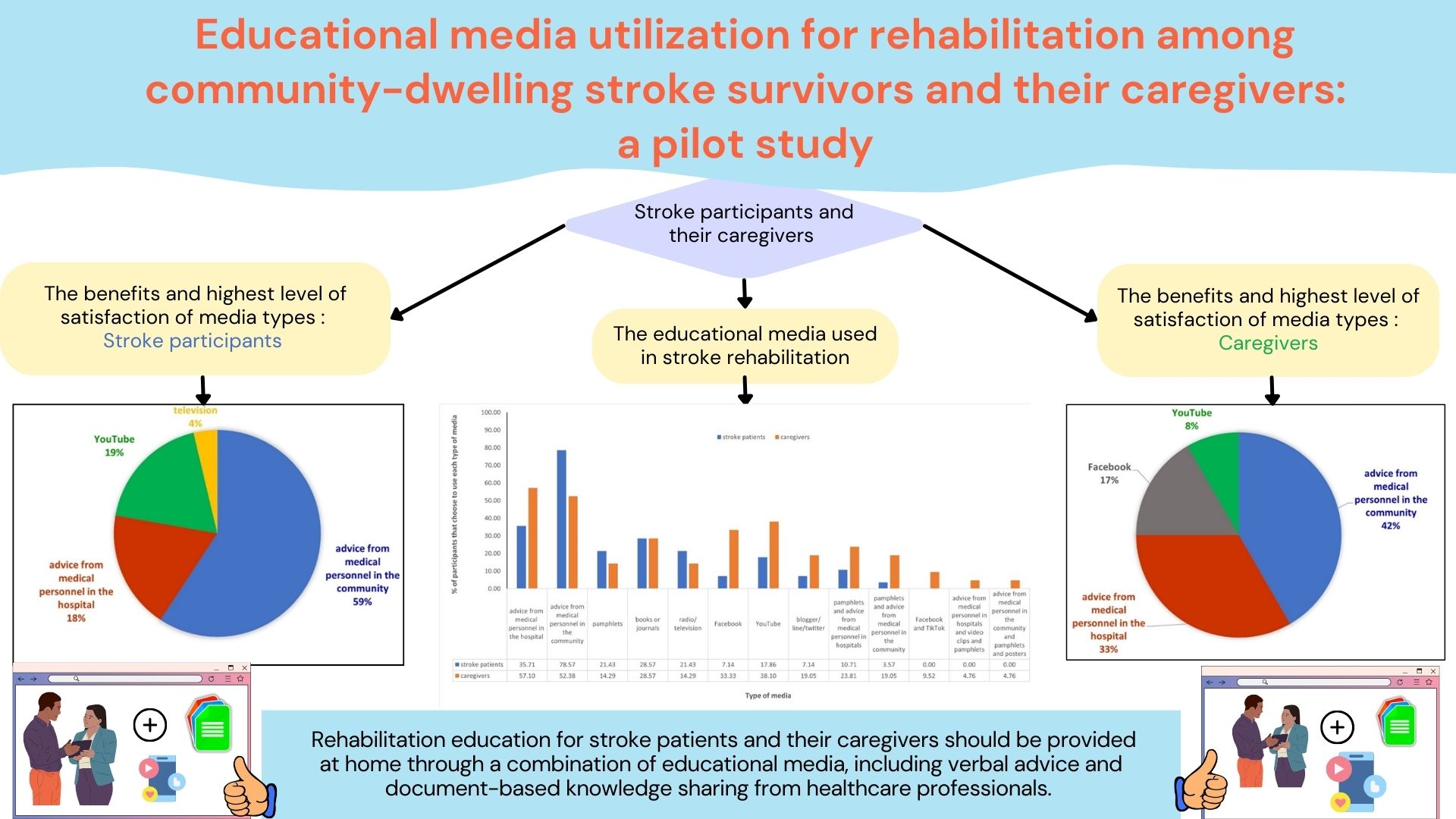Educational media utilization for rehabilitation among community-dwelling stroke survivors and their caregivers: a pilot study
Main Article Content
Abstract
Background: Recently, there has been an increasing number of stroke patients. Those who survive still need continuous rehabilitation after being discharged from the hospital. The information and knowledge on stroke rehabilitation at home is crucial for these patients and their caregivers. However, there has never been a study of educational media on rehabilitation for those patients and their caregivers in Thailand.
Objective: To explore the educational media used in stroke rehabilitation, list their benefits, and the most satisfying media type for stroke participants and their caregivers after hospital discharge.
Materials and methods: Twenty-eight stroke patients and twenty-one primary caregivers from two Subdistrict Municipalities and two Districts in Chaing Mai province were recruited using purposive sampling methods. All participants were aged 18 years and over and could communicate in Thai. All the stroke participants had no cognitive impairment screening by the Mental Status Examination-10 (MSET-10) and had self-rehabilitation therapy at home. A Questionnaire on the use of educational media in stroke rehabilitation with the index of item objective congruence (IOC) range between 0.67-1.00 was used for data collection. The statistics used were descriptive.
Results: Stroke patients used information obtained primarily from medical personnel in the community (78.57%), while caregivers used advice from medical personnel the most in the hospitals (57.14%). Regarding the highest satisfaction with educational media, 59% of stroke patients and 42% of caregivers were satisfied with advice from medical personnel in the community. Stroke patients revealed that using a combination of advice from medical professionals, brochure-based media, and only document media was the most beneficial in providing knowledge about rehabilitation. For caregivers, the use of a combination of advice from medical professionals along with paper and video media, and the use of knowledge gained from online channels were the most beneficial.
Conclusion: Rehabilitation education materials used by stroke patients and their caregivers at home offer the highest level of satisfaction for the patients and caregivers if the medium of people who can give advice and communicate on issues meets their needs. In addition, patients and caregivers agreed that rehabilitation education should include more than one form of media for maximum benefit. Therefore, health professionals should consider the format of educational media appropriate to the needs of service recipients to be able to use them most effectively.
Article Details

This work is licensed under a Creative Commons Attribution-NonCommercial-NoDerivatives 4.0 International License.
Personal views expressed by the contributors in their articles are not necessarily those of the Journal of Associated Medical Sciences, Faculty of Associated Medical Sciences, Chiang Mai University.
References
Tiamkao S. Incidence of stroke in Thailand. Thai J Neurol 2022; 39: 39-46.
Murphy SJ, Werring DJ. Stroke: causes and clinical features. Medicine (Abingdon). 2020; 48(9): 561-6. doi: 10.1016/j.mpmed.2020.06.002.
Suwanwela NC. Stroke epidemiology in Thailand. J Stroke. 2014; 16(1): 1-7. doi: 10.5853/jos.2014.16.1.1.
Suksathien R. Accessibility to Medical Rehabilitation Service for Acute stroke at Maharat Nakhon Ratchasima Hospital: Related Factors and Outcomes. J Thai Rehabil Med. 2014; 24(2): 37-43.
Pindus DM, Mullis R, Lim L, Wellwood I, Rundell AV, Abd Aziz NA, et al. Stroke survivors’ and informal caregivers’ experiences of primary care and community healthcare services - A systematic review and metaethnography. PLoS One. 2018; 13(2): e0192533. doi: 10.1371/journal.pone.0192533.
Duncan PW, Zorowitz R, Bates B, Choi JY, Glasberg JJ, Graham GD, et al. Management of Adult Stroke Rehabilitation Care: a clinical practice guideline. Stroke. 2005; 36(9): e100-43. doi: 10.1161/01.STR.0000180861.54180.FF.
Changmai S. Supportive care needs of family caregiver. CUTJ. 2016; 22(3): 424-35.
Finch E, Minchell E, Cameron A, Jaques K, Lethlean J, Shah D, et al. What do stroke survivors want in stroke education and information provision in Australia? Health Soc Care Community. 2022; 30(6): e4864-e72. doi: 10.1111/hsc.13896.
Pitthayapong S. Situations, problems, and barriers of post-stroke care in the transitional period from hospital to home. TRC Nurs J. 2018; 11: 26-39.
Gillen G, Nilsen DM, Attridge J, Banakos E, Morgan M, Winterbottom L, et al. Effectiveness of interventions to improve occupational performance of people with cognitive impairments after stroke: an evidencebased review. Am J Occup Ther. 2015; 69(1): 69011 80040p1-9. doi: 10.5014/ajot.2015.012138.
Hatem SM, Saussez G, Della Faille M, Prist V, Zhang X, Dispa D, et al. Rehabilitation of Motor Function after Stroke: A Multiple Systematic Review Focused on Techniques to Stimulate Upper Extremity Recovery. Front Hum Neurosci. 2016; 10: 442. doi: 10.3389/fnhum.2016.00442.
Jolliffe L, Lannin NA, Cadilhac DA, Hoffmann T. Systematic review of clinical practice guidelines to identify recommendations for rehabilitation after stroke and other acquired brain injuries. BMJ Open. 2018; 8(2): e018791. doi: 10.1136/bmjopen-2017-018791.
Boongird P. Mental State Examination T10. Dementia Association of Thailand Newsletter. 2018; (10).
Eames S, Hoffmann T, Worrall L, Read S. Stroke patients’ and carers’ perception of barriers to accessing stroke information. Top Stroke Rehabil. 2010; 17(2): 69-78. doi: 10.1310/tsr1702-69.
Eames S, Hoffmann T, Worrall L, Read S. Delivery styles and formats for different stroke information topics: patient and carer preferences. Patient Educ Couns. 2011; 84(2): e18-23. doi: 10.1016/j.pec.2010.07.007.
Crocker TF, Brown L, Lam N, Wray F, Knapp P, Forster A. Information provision for stroke survivors and their carers. Cochrane Database Syst Rev. 2021; 11(11): CD001919. doi: 10.1002/14651858.CD001919.pub4.
Pakdee P, Chinchai P. The influence of home visit program on functional abilities and quality of life in persons with disabilities resulting from stroke. Bull Chiang Mai Assoc Med Sci. 2016; 49(2): 276-85. doi: 10.14456/jams.2016.24.
Chinchai P, Jindakham N, Punyanon T. Effect of rehabilitation education to village volunteers toward activities of daily living performance of people with disabilities resulting from stroke. Bull Chiang Mai Assoc Med Sci. 2015; 48(3): 241-50. doi: 10.14456/jams.2015.15.
Teuschi Y BM. Stroke Education: Discrepancies among Factors Influencing Prehospital Delay and Stroke Knowledge. Int J Stroke. 2010; 5(3): 187-208. doi: 10.1111/j.1747-4949.2010.00428.x.


